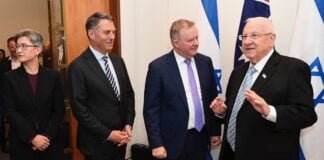ALMOST THE first words uttered by the new premier Nathan Rees were along the lines of “I’ve been briefed by Treasury. It’s worse than I thought. We could lose the AAA credit rating. We’ve been living beyond our means. We’ll have to tighten our belt. Sale of retail electricity will go ahead.”
But how bad is this crisis really?
Former treasurer Michael Costa claimed that losing the AAA rating (down to AA+, like Tasmania) would cost the state $500 million in extra interest payments, meaning services would need to be cut. Rees has twice repeated this. But Bob Walker, professor of accountancy at Sydney University, and Betty Con Walker, economist and former NSW Treasury official, are certain the actual cost would be between just $7 million and $14 million a year, out of a total budget of about $48 billion, a “trivial amount”.
The winds of recession may be cutting tax revenue for the state, but to make up a crisis and to demand cutbacks and sell-offs of assets like power and ferries shows how Labor politicians have become prisoners of their very conservative Treasury advisers.
Is a government budget really like a household budget?
Rees claims that we’ve been “living beyond our means” and that like a household that is spending more than it earns we need to tighten our belts.
But unlike individuals in a financial tight spot, governments have no problem borrowing to meet any temporary cash problems, or to fund infrastructure investments. As long as the state can meet its repayments (and it can increase taxes if necessary—preferably on the rich or coal exports) it is no problem at all.
Indeed productive investments that lead to better health and education, or that make it easier to get around, will repay the state with a stronger revenue base into the future.
For twenty years governments have pushed a policy of zero borrowing and of debt reduction. The blowback is now here in NSW, with inadequate transport systems, ancient school buildings, a huge queue for public housing and sick hospitals.
Betty Con Walker went and got the figures on NSW debt. She told ABC’s Stateline they show that at June 2008, the net NSW state debt was $22 billion, or 6.2 per cent of gross state product.
She says, “It compares with international developed countries at more than 40 per cent. Some of them are as high as 80 per cent of their gross state product. It’s going to rise, according to the budget papers, to $41.8 billion over the next three years. Now, that will still only be 9.1 per cent of the gross state product; still a very modest indebtedness ratio for the state. And these figures have been there and available to the credit rating agencies”.
Despite the scare campaign, neither ratings agency has put NSW on “credit watch” or shown any concern that infrastructure spending cannot be easily paid for by borrowing over the long term.
How was infrastructure paid for in the past?
Through the colonial period and through most of the twentieth century governments in Australia relied on borrowing to pay for infrastructure: roads and bridges; power, water, gas and sewerage and drainage systems; public buildings – schools and hospitals; public transport systems; public housing; cultural and sports facilities.
Much of this was done through issuing “bonds” (pieces of paper promising to repay with interest per annum) to the public. Now governments borrow directly from the banks. There is no reason why the extensive infrastructure needed to build a clean energy sector, modernise public transport and refurbish other public facilities cannot be done through borrowing.
Why the obsession with avoiding debt?
In the 1980s free market economists argued that governments were too big, taxed too much, spent too much and interfered too much with the “normal workings of the market”. In particular they argued that government borrowing “crowded out” private sector investment by increasing the demand for funds, hence raising interest rates. If this was ever true, now with $1.17 trillion in superannuation funds under management [APRA, 25/09/08], there is plenty of money searching for a secure investment, like state borrowing.
A more compelling and permanent argument for the ruling class is that government budget cuts send the right message to the working class: that when capitalism goes into crisis the state is there to discipline workers, not help them out.
By Bruce Knobloch





